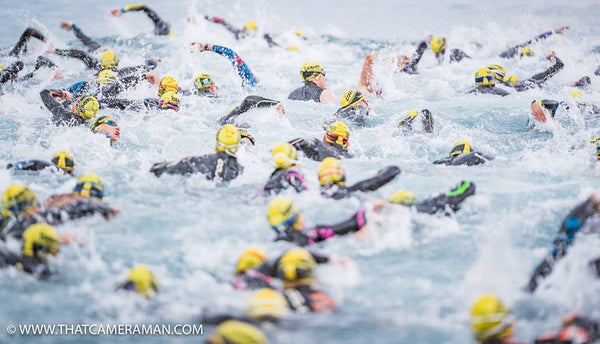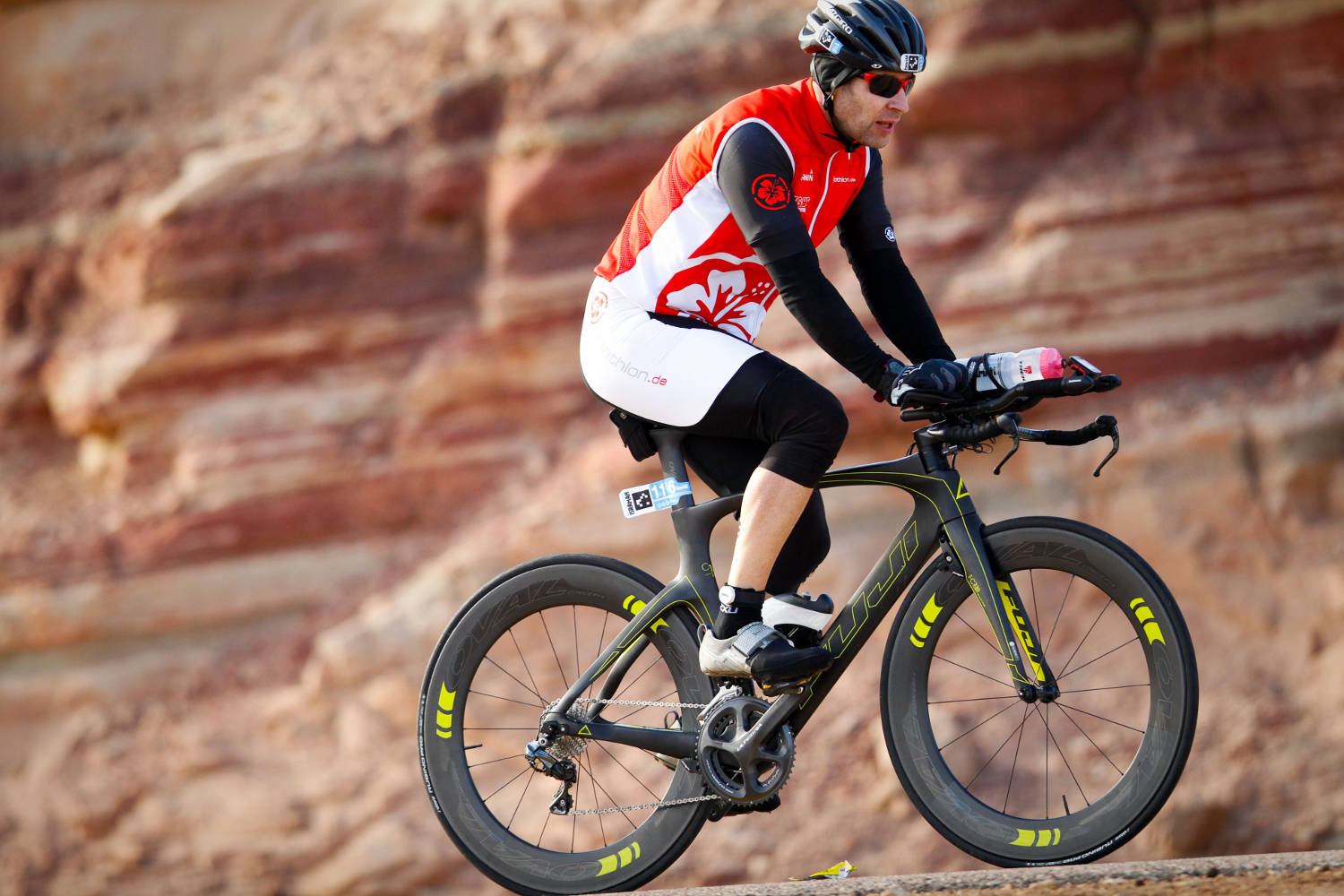
Wie üblich wollte ich am Tag vor dem Rennen noch einmal alles „durchbewegen“. Das heißt, ich gehe normalerweise ca. 500 Meter schwimmen und jeweils ca. 15-20 Minuten radeln und 15-20 Minuten laufen, wenn möglich alles direkt hintereinander. In die einzelnen Disziplinen baue ich normalerweise noch ca. 1 Minute im Wettkampftempo ein. Das hilft mir, noch mal ein bisschen Spannung für das Rennen aufzubauen, ohne mich dabei „abzuschießen“. An diesem Donnerstag – beim Israman ist der Wettkampf am Freitag - war aber alles anders. Bereits vormittags zog es kontinuierlich zu und am späten Vormittag begann es zu regnen, zu stürmen und zu gewittern. Da ich mein Rad noch aufbauen musste, war ich sehr spät dran. Im Gewitter wollte ich dann nicht mehr fahren und schwimmen. Außerdem sollte laut Zeitplan das Fahrrad und der Beutel für die Wechselzone 2 bis 16:30 Uhr eingecheckt sein. Also verzichtete ich auf mein übliches „Aufwärm-Programm“. Am Check-in stellte sich jedoch heraus, dass dieser wegen des Sturms auf den nächsten Morgen verschoben war, um Schäden an den Rädern zu vermeiden. Damit war aber der Tag auch schon gelaufen und nach einem ausführlichen Abendessen, ging es ab ins Bett.

Raceday

Den Wecker hatte ich auf 5:10 gestellt. Da mein Hotel, das Isrotel Royal Garden, perfekt am Start, Ziel, sowie an der Wechselzone lag, hatte ich kurze Wege am Morgen und konnte ganz entspannt alles erledigen. Nach einem kurzen Frühstück und Check-in von Rad und Wechselbeuteln ging ich noch einmal kurz auf mein Zimmer, um meinen Neo und Schwimmzeug zu holen. Von dort startete ich gleich zum Schwimmstart und pünkltich um 6:37 auf die Schwimmstrecke. Das Rote Meer, in dem das Schwimmen stattfindet, hat ganzjährig eine Temperatur von ca. 23 Grad. D.h. es ist auch am Morgen super-angenehm. Außerdem ist das Wasser sehr klar und man kann lange den Grund, eigentlich immer die Schwimmer vor sich und viele Fische sehen. Beim Schwimmen verschluckte ich mich einmal und musste feststellen, dass der Salzgehalt ebenfalls sehr hoch ist. Man merkt es daran, dass das Salzwasser stark im Mundraum brennt. Der hohe Salzgehalt und der Neo sorgen natürlich für eine super Wasserlage. Ich ging das Rennen bewusst locker an, weil meine Vorbereitung eher bescheiden war. Es lief alles gut, wie gesagt, die Bedingungen waren sehr angenehm und ich konnte entspannt relativ weit vorn in meiner Startgruppe mitschwimmen. Nach 31:44 Minuten kam ich aus dem Wasser, womit ich total zufrieden war. Der Weg zur Wechselzone ist mit ca. 400 Metern ziemlich lang. Auch hier und beim Wechsel ließ ich mir mit 12 Minuten viel Zeit, denn mir war wichtig, ausreichend viel und gut anzuziehen, weil ich wusste, dass nun der knackige Teil anstand.
Gute Vorbereitung?
Gleich in der 1. Stunde auf dem Rad, musste ich in mehrfacher Hinsicht für meine schlechte Vorbereitung bezahlen. Zum einen hatte ich mich nicht besonders, ehrlich gesagt gar nicht, mit meiner Übersetzung am Rad auseinander gesetzt. Wie sich herausstellte, wären aber auf den steilen Anstiegen ein paar Zähne mehr an der Kassette ganz nett gewesen. Zum anderen merkte ich ziemlich schnell, dass ich mein Stabis – obwohl ich das ja allen meinen Athleten predige – in den letzten 2 Monaten arg vernachlässigt hatte. Also beendete ich den ersten Anstieg über ca. 16 Kilometer mit empfindlichen Rückenschmerzen im unteren Rücken, die ich auch leider über das ganze Rennen nicht mehr wegbekam. Aber dazu später mehr.
Start-Anstieg geschafft...nicht ganz
Wenn man sich am Ende des Start-Anstiegs die Wechselzone 2, die man aber erst auf dem Rückweg benutzen darf, darüber freut, dass der Berg vorbei ist, begrüßt einen als erstes ein netter, kackiger Frontwind. In meiner Gedankenwelt tauchten Worte auf, die mit „Sch...“ anfangen. Wenn man außerdem meint, dass man mit dem Start-Anstieg den schwierigen Teil geschafft hat, wird man auch eines Besseren belehrt. Man hat dann noch nicht einmal die Hälfte der Höhenmeter überwunden. Grob gesagt, müssen noch zwei längere Anstiege á 200 Höhenmetern und das natürlich in jede Richtung (hin und zurück) überwunden werden. Insgesamt hat die Strecke der Halbdistanz also etwa 1.800 Höhenmeter. Das bedeutet aber auch, dass die Strecke fast nie flach ist. Hinzu kommen Winde, die vermutlich begünstigt durch die zerklüftete Landschaft permanent drehen. Ein Opfer dieser Cross-Winde war unter anderem der auf der Langdistanz führende Pole, der nach einem Sturz das Rennen nicht beenden konnte. Darüberhinaus hat es in den Bergen empfindliche 5 Grad, die die Belastung zustätzlich anspruchsvoll machen. Wie schon beschrieben kam ich oben am Start-Anstieg mit kräftigen Schmerzen im Rücken an. Mein unterer Rücken hatte sich wegen der großen Belastung, mit dicken Gängen zu fahren, verkrampft. Oben angekommen stieg ich erst einmal ab und musste mich ausführlich stretchen und meinen Rücken lockern. Das war halbwegs erfolgreich, sodass ich auf den nächsten 40 Kilometern ordentlich Boden gut machen konnte. Ich überholte bestimmt 50 andere Athleten und kam richtig gut voran. Das war eigentlich der schönste Teil des Rennens. Wie geplant genoss ich die tolle Landschaft und auch die heftigen, drehenden Seitenwinde auf den Abfahrten konnte ich gut händeln.

Beschreibung Radstrecke
Der Kurs führt durch die südliche Negev-Wüste. Man ist an eine Mondlandschaft erinnert, da alles sehr zerklüftet ist und man fast keine Vegetation sieht. An vielen Stellen, sieht man durch die Erosion die vielen verschieden-farbigen Gesteinsschichten, die tausende, vielleicht Millionen von Jahren übereinander abgelagert haben. Ein kräftiger Wind fegt permanent über diese raue Landschaft hinweg. Auf der einen Seite fährt man lange Zeit an der ägyptisch-israelischen Grenze entlang. Diese ist durch einen robusten ca. 4 Meter hohen und mit Stacheldraht bewehrten Zaun markiert. Auf beiden Seiten der Grenze befinden sich in regelmäßigen Abständen Forts und Militär-Bunker. Auch einige israelische Soldaten stehen voll bewaffnet mehr oder weniger interessiert an der Strecke und beobachten von ihrem Grenzposten aus das ungewöhnliche Treiben. Auf der anderen Seite kann man immer wieder über das Tal hinweg nach Jordanien schauen. Eine für mich ungewöhnliche, fast unwirkliche Situation, dass man als Radfahrer überwiegend von Soldaten, die ihre automatischen Waffen umgehängt haben, angefeuert wird.

Berghoch mit Gegenwind
Am Wendepunkt angekommen, ging es sofort wieder bergauf und der Wind blies uns ordentlich ins Gesicht. Meine Durchschnittsgeschwindigkeit auf dieser etwas weniger als 2. Hälfte des Rad-Kurse lag gefühlt bei unter 20 km/h. Also dümpelte ich mit Rückenschmerzen und mehreren Stretching-Pausen bis zur Wechselzone 2. Gefühlt hatten mich mittlerweile die 50 Athleten, an denen ich vorher locker vorbei gerollert war, alle wieder überholt. Jetzt wird der eine oder andere sagen, da ist der Schick ja viel zu schnell angegangen. "Oh contraire", würde ich entgegnen. Ich bin die ganze Zeit kontrolliert mit Puls im Bereich um die 140 Schläge (was für mich eher locker ist) gefahren, ich habe unterwegs gut gegessen und wenn ich zu schnell angegangen wäre, dann hätte der Einbruch schon deutlich früher kommen müssen. Aber egal, auf jeden Fall war der Weg zurück ziemlich schmerzhaft.

Was soll man denn eigentlich anziehen
In der Wechselzone 2 überlegte ich kurz, was ich ausziehen, bzw. anlassen sollte. Ich trug meinen Aero-Einteiler mit Armlingen, Beinlingen, Windweste und eine Windblocker Mütze. Ich entschied mich, erst einmal alles anzulassen, weil es oben echt zapfig war. Und das gute an Armlingen und Beinlingen ist, dass man die ja auch super herunterrollen kann, wenn es zu warm wird. Beim Bergab-Lauf brauchte es ca. 3km bis meine eingefrorenen Füsse wieder zum Leben erwachten. Bei jedem Schritt spürte ich meinen Rücken, da ich bergab aber nicht drücken musste, war es ein wenig besser als beim Radeln. Nach ca. 8 km kommt eine ca. 2km lange Pendelstrecke, die weitgehend flach ist. Hier spürte ich meinen Rücken so sehr, dass ich 2x eine Gehpause einlegen musste. Ein Stück weiter ging es dann wieder bergab, aber ab da war der (Lauf-) Ofen dann komplett aus. D.h. Trotz mehrerer Versuche, konnte ich nicht mehr als maximal 100 Meter laufen und wanderte so friedlich vor mich hin. An dieser Stelle möchte ich ein kures Wort über die anderen, meist israelischen Teilnehmer sagen: An meiner Startnummer konnte man sehen, dass ich Deutscher bin und wie ich heiße. Es war unglaublich wieviele andere Athleten mich freundlich und fürsorglich angesprochen haben:“Are you ok“, „do you need a gel“, „do you want some pain killers“. Ebenso die vielen Zuschauer auf der Laufstrecke. Die Leute waren echt nett und haben mich immer wieder versucht mitzunehmen und zum Laufen zu animieren. Das habe ich so auch noch nie erlebt. (Aber ich bin auch noch nie so viel in einem Triathlon gegangen.) Alles andere ist Geschichte, nach einem mehr als die Hälfte gewanderten Halbmarathon in 2:26h lief ich mit einer Gesamtzeit von 7:31 h ins Ziel ein. Damit bin ziemlich genau im Mittelfeld, also Platz 324 von 714 Finishern gelandet.
Fazit
Klar, das hab ich mir ein bisschen anders vorgestellt. Aber ich bin froh, um das Erlebnis und dass ich das Rennen trotz seiner Härten durchgezogen habe. Während des Rennen habe ich zugegebenermaßen schon 2x darüber nachgedacht, aufzugeben. Das war zum ersten Mal auf dem Start-Anstieg und zum zweiten Mal war die Versuchung an T2 einfach mit dem Rad weiterzufahren und ins Hotel zu rollern schon da. Der Israman ist die anspruchsvollste Mitteldistanz, die ich bisher absolviert habe. Er hat meine Erwartungen - ich wusste ja, dass es viele Höhenmeter gibt, dass es windig wird und dass es auch kalt sein kann - noch übertroffen. Hier kann man nicht schummeln oder sich verstecken. Auch drei Tage nach dem Rennen spüre ich noch meinen Rücken und meine Oberschenkel. Das Ding ist wirklich hart! Ich fühle mich jetzt nicht so, als ob ich eine Rechnung offen habe. Ich weiß, dass ich das Rennen mit ordentlicher Vorbereitung deutlich schneller absolvieren kann, wenn ich einfach nur den Halbmarathon durchlaufe. Die Athleten in Israel sind echt rührig und eine eingeschworene Gemeinschaft. Und last not least, mein persönliches Learning: Ich werde nie wieder ein Rennen ohne ausreichende Vorbereitung machen. Ansonsten starte ich lieber nicht mehr.
Zur Homepage vom Israman Du willst noch mehr über mich erfahren? Dann werde mein Freund auf Facebook: Ralph auf Facebook
Fotos: ZalemOti.com, Darren Wheeler




















